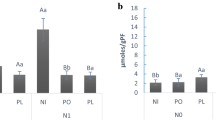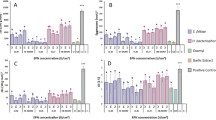Abstract
Efficacy of Pseudomonas aeruginosa alone or in combination with Paecilomyces lilacinus was evaluated in the control of root-knot nematode and root-infecting fungi under laboratory and field conditions. Ethyl acetate extract (1 mg/ml) of P. lilacinus and P. aeruginosa,respectively, caused 100 and 64% mortality of Meloidogyne javanica larvae after 24 h. Ethyl acetate fractions of biocontrol agents were more effective than hexane extracts in the suppression of M. javanica larvae, indicating that active nematicidal compounds are intermediary in polarity. In field experiments, biocontrol fungus and bacterium significantly suppressed soilborne root-infecting fungi including Macrophomina phaseolina, Fusarium oxysporum, Fusarium solani, Rhizoctonia solani and Meloidogyne javanica, the root-knot nematode. P. lilacinus parasitized eggs and female of M. javanica and this parasitism was not significantly influenced in the presence of P. aeruginosa. P. aeruginosa was reisolated from the inner root tissues of tomato, whereas P. lilacinusdid not colonize tomato roots.
Similar content being viewed by others
References
Alam M M 1990 Paecilomyces lilacinus - a nematode biocontrol agent. In Nematode Biocontrol: Aspects and Prospects. Eds. MS Jairajpuri, MM Alam and I Ahmed. pp 71–82. CBS Publishers and Distributors, Delhi, India.
Cayrol J C, Djian C and Pijarowski L 1989 Study of the nematocidal properties of the culture filtrate of the nematophagous fungus Paecilomyces lilacinus. Rev. Nematol. 12, 331–336.
Devidas P and Rehberger L A 1992 The effects of exotoxin (thuringiensin) from Bacillus thuringiensis on Meloidogyne incognita and Caenorhabditis elegans. Plant Soil 145, 115–120.
Gomez K A and Gomez A A 1984 Statistical Procedures for Agriculture Research. 2nd ed. Wiley, New York. 680 p.
Isogai A, Suzuki A, Higashikawa S, Kuyama S and Tamura S 1980 Constituents of a peptidal antibiotic P-168 produced by Paecilomyces lilacinus (Thom.) Samson. Agric. Biol. Chem. 44, 3029–3031.
Jatala P 1985 Biological control of nematodes. In 'Advanced Treatise on Meloidogyne, Biology and Control'. Eds. JN Sasser and CC Carter. pp 303–308. North Carolina State Graphics.
Jatala P 1986 Biological control of plant-parasitic nematodes. Annu. Rev. Phytopathol. 24, 453–489.
Morgan-Jones G, White J F and Rodriguez-Kabana R 1984 Phytonematode pathology: Ultra-structural studies. II. Parasitism of Meloidogyne arenaria eggs and larvae by Paecilomyces lilacinus. Nematropica 14, 57–71.
Nash S M and Snyder W C 1962 Quantitative estimations by plate counts of propagules of the bean root rot Fusarium in field soils. Phytopathology 52, 567–572.
Nicolay R and Sikora R A 1991 Interrelationships between fungal egg parasitism in Heterodera schachtii (Schmidt) and nematode population density. Rev. Nematol. 14, 231–249.
Okafor N 1967 Decomposition of chitin by micro-organisms isolated from a temperate and a tropical soil. Nova Hedwigia 13, 209–226.
Oostendorp M and Sikora R A 1990 In vitro interrelationships beetween rhizosphere bacteria and Heterodera schachtii. Rev. Nematol. 13, 269–274.
Pennypacker B W, Knievel D P, Leath K T, Pell E J and Hill J R R 1990 Analysis of photosynthesis in resistance and susceptible alfalfa clones infected with Verticillium albo-atrum. Phytopathology 80, 1300–1306.
Perveen S, Ehteshamul-Haque S and Ghaffar A 1998 Efficacy of Pseudomonas aeruginosa and Paecilomyces lilacinus in the control of root rot-root knot disease complex of some vegetables. Nematol. Medit. 26, 209–212.
Pillay V K and Nowak J 1997 Inoculum density, temperature and genotype effect on in vitro growth promotion and epiphytic and endophytic colonization of tomato (Lycopersicon esculentum L.) seedlings inoculated with a Pseudomonad bacterium. Can. J. Microbiol. 43, 354–361.
Sharma V K and Nowak J 1998 Enhancement of Verticillium wilt resistance in tomato transplant by in vitro co-culture of seedlings with a plant growth promoting rhizobacterium (Pseudomonas sp. strain PsJN). Can. J. Microbiol. 44, 528–536.
Sheikh A H and Ghaffar A 1975 Population study of sclerotia of Macrophomina phaseolina in cotton fields. Pak. J. Bot. 7, 13–17.
Siddiqui I A, Ehteshamul-Haque S and Ghaffar A 1998 Effect of rhizobia and fungal antagonists in the control of root infecting fungi on sunflower and chickpea. Pak. J. Bot. 30, 279–286.
Siddiqui I A, Ehteshamul-Haque S and Ghaffar A 1999 Use of Pseudomonas aeruginosa and fungal antagonists in the control of root knot-root rot disease complex on mungbean and mashbean. Pak. J. Nematol. 17, 155–167.
Wilhelm S 1955 Longevity of the Verticillium wilt fungus in the laboratory and field. Phytopathology 45, 180–181.
Weller D M 1988 Biocontrol of soil-borne plant pathogens in the rhizosphere with bacteria. Annu. Rev. Phytopathol. 26, 379–407.
Author information
Authors and Affiliations
Rights and permissions
About this article
Cite this article
Siddiqui, I.A., Qureshi, S.A., Sultana, V. et al. Biological control of root rot-root knot disease complex of tomato. Plant and Soil 227, 163–169 (2000). https://doi.org/10.1023/A:1026599532684
Issue Date:
DOI: https://doi.org/10.1023/A:1026599532684




